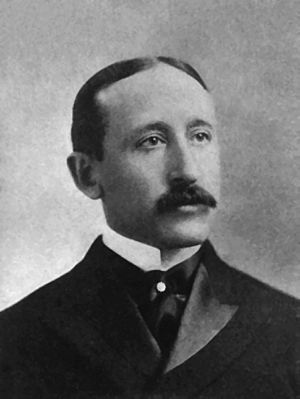James Ewing (pathologist) facts for kids
James Stephen Ewing (born December 25, 1866, in Pittsburgh – died May 16, 1943, in New York City) was an American doctor who studied diseases, especially cancer. He became the first professor of pathology (the study of diseases) at Cornell University. Dr. Ewing discovered a type of bone cancer that was later named after him: Ewing sarcoma.
Contents
Early Life and Education
James Ewing was born in 1866 into an important family in Pittsburgh. When he was 14, he became sick with a bone infection called osteomyelitis and had to stay in bed for two years.
He first earned his bachelor's degree in 1888 from Amherst College. After that, he studied medicine at the College of Physicians and Surgeons of New York from 1888 to 1891. He later returned to teach there.
A Pioneer in Cancer Research
In 1899, Dr. Ewing became the first professor of clinical pathology at the new Medical College of Cornell University in New York. He was the only full-time professor there.
In 1902, Dr. Ewing helped create one of the first special funds for cancer research. This funding came from a generous donation by Arabella Huntington. With this support, Dr. Ewing became a very important experimental oncologist, which is a doctor who studies and treats cancer.
He also helped start important groups dedicated to fighting cancer. In 1907, he helped found the American Association for Cancer Research. In 1913, he helped create the American Society for the Control of Cancer, which is now known as the American Cancer Society.
Developing New Treatments
In 1910, Dr. Ewing wanted to create a special research center at New York Hospital. When that didn't work out, he teamed up with Memorial Hospital (which later became Memorial Sloan Kettering Cancer Center). A kind businessman named James Douglas gave $100,000 to help. This money allowed the hospital to set up 20 beds for research, buy equipment for working with radium (a substance used in treatment), and create a special lab.
Mr. Douglas's excitement and funding for developing radiation therapy for cancer inspired Dr. Ewing. He became one of the first doctors to develop this important treatment. Soon, Dr. Ewing took charge of the research at Memorial Hospital.
Discovering Ewing Sarcoma
In 1919, Dr. Ewing published his famous book, Neoplastic Diseases: A Text-Book on Tumors. This book was translated into many languages and became a key guide for understanding and diagnosing human cancer.
In 1921, he published a paper describing a type of bone tumor. This specific type of tumor was later named after him: Ewing sarcoma.
Leading Memorial Hospital
In 1931, Dr. Ewing was officially named president of Memorial Hospital. He was even featured on the cover of Time Magazine as "Cancer Man Ewing." The article called him one of the most important cancer doctors of his time. He worked at Memorial Hospital until he retired in 1939.
Under his leadership, Memorial Hospital became a great example for other cancer centers in the United States. It combined caring for patients with important research in both clinics and labs. People said that Dr. Ewing was so important to Memorial Hospital that "Every institution is but the lengthening shadow of some man." Dr. Ewing truly was Memorial Hospital.
In 1951, The James Ewing Hospital opened in New York City. This hospital was built to treat cancer patients who were poor.
See also
 In Spanish: James Ewing para niños
In Spanish: James Ewing para niños


